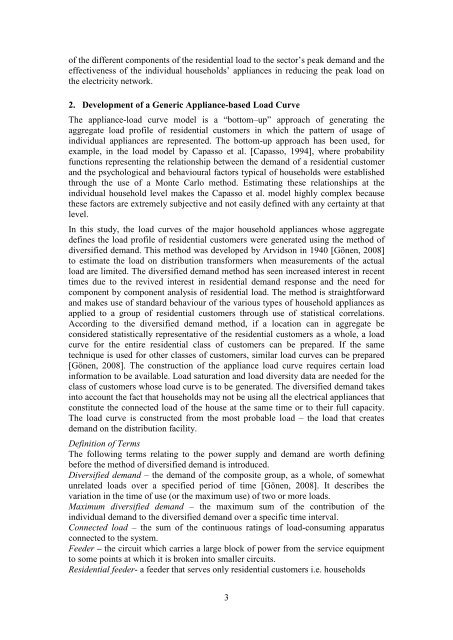Download (202kB) - Murdoch Research Repository
Download (202kB) - Murdoch Research Repository
Download (202kB) - Murdoch Research Repository
You also want an ePaper? Increase the reach of your titles
YUMPU automatically turns print PDFs into web optimized ePapers that Google loves.
of the different components of the residential load to the sector’s peak demand and the<br />
effectiveness of the individual households’ appliances in reducing the peak load on<br />
the electricity network.<br />
2. Development of a Generic Appliance-based Load Curve<br />
The appliance-load curve model is a “bottom–up” approach of generating the<br />
aggregate load profile of residential customers in which the pattern of usage of<br />
individual appliances are represented. The bottom-up approach has been used, for<br />
example, in the load model by Capasso et al. [Capasso, 1994], where probability<br />
functions representing the relationship between the demand of a residential customer<br />
and the psychological and behavioural factors typical of households were established<br />
through the use of a Monte Carlo method. Estimating these relationships at the<br />
individual household level makes the Capasso et al. model highly complex because<br />
these factors are extremely subjective and not easily defined with any certainty at that<br />
level.<br />
In this study, the load curves of the major household appliances whose aggregate<br />
defines the load profile of residential customers were generated using the method of<br />
diversified demand. This method was developed by Arvidson in 1940 [Gönen, 2008]<br />
to estimate the load on distribution transformers when measurements of the actual<br />
load are limited. The diversified demand method has seen increased interest in recent<br />
times due to the revived interest in residential demand response and the need for<br />
component by component analysis of residential load. The method is straightforward<br />
and makes use of standard behaviour of the various types of household appliances as<br />
applied to a group of residential customers through use of statistical correlations.<br />
According to the diversified demand method, if a location can in aggregate be<br />
considered statistically representative of the residential customers as a whole, a load<br />
curve for the entire residential class of customers can be prepared. If the same<br />
technique is used for other classes of customers, similar load curves can be prepared<br />
[Gönen, 2008]. The construction of the appliance load curve requires certain load<br />
information to be available. Load saturation and load diversity data are needed for the<br />
class of customers whose load curve is to be generated. The diversified demand takes<br />
into account the fact that households may not be using all the electrical appliances that<br />
constitute the connected load of the house at the same time or to their full capacity.<br />
The load curve is constructed from the most probable load – the load that creates<br />
demand on the distribution facility.<br />
Definition of Terms<br />
The following terms relating to the power supply and demand are worth defining<br />
before the method of diversified demand is introduced.<br />
Diversified demand – the demand of the composite group, as a whole, of somewhat<br />
unrelated loads over a specified period of time [Gönen, 2008]. It describes the<br />
variation in the time of use (or the maximum use) of two or more loads.<br />
Maximum diversified demand – the maximum sum of the contribution of the<br />
individual demand to the diversified demand over a specific time interval.<br />
Connected load – the sum of the continuous ratings of load-consuming apparatus<br />
connected to the system.<br />
Feeder – the circuit which carries a large block of power from the service equipment<br />
to some points at which it is broken into smaller circuits.<br />
Residential feeder- a feeder that serves only residential customers i.e. households<br />
3
















